Understanding Rip Tide Movement: A Comprehensive Exploration

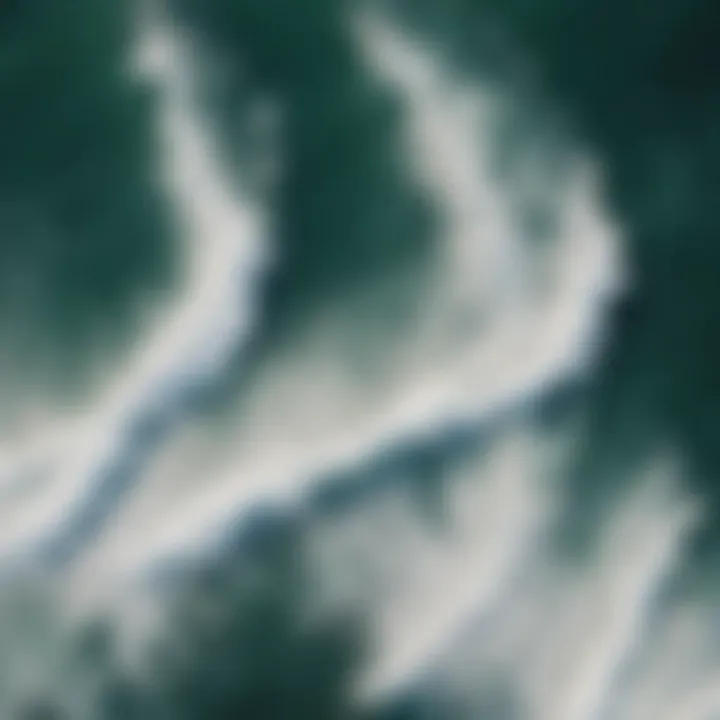
Intro
Rip tides, or rip currents as they are more commonly referred to in the world of water sports, are natural phenomena that pose significant challenges for beachgoers. They might look innocuous, gently lapping at the shore, leaving many unaware of the danger lurking just beneath the surface. Despite their threat, this current can be understood, navigated, and even utilized by skilled surfers and swimmers if they know what to look for and how to respond.
This article covers a range of topics, from the intricate dynamics that govern rip tides to the essential skills and techniques necessary for both beginners and experienced watersport enthusiasts. Knowing how to identify these currents is essential, not only for personal safety but also for enjoying what the ocean has to offer to those daring enough to partake in its waters. By shedding light on both practical skills and theoretical knowledge, this guide aspires to ensure that whether you're paddling out for a surf session or enjoying a day of leisure swimming, you're equipped with the wisdom required to stay safe and informed.
The information contained herein is not merely academic; it holds real-world implications for water sports enthusiasts. Understanding the physics behind rip tides can empower individuals to make informed decisions about their safety and enhance their overall beach experience. Let's dive into the essential techniques, skills, and equipment necessary for thriving in environments where rip tides exist.
Defining Rip Tides
Understanding rip tides is akin to having a compass in unfamiliar terrain. It's essential for anyone who enjoys oceanic adventures or even those who occasionally stroll along the beach. Grasping the concept of rip tides not only enriches our knowledge but also highlights the safety measures needed to ensure that fun doesn't morph into a hazardous situation.
What Is a Rip Tide?
A rip tide, often referred to as a rip current, is a powerful, narrow channel of water that flows away from the shore. Imagine standing on the beach, and suddenly, you feel a tug pulling you back into the deep blue. That sensation is often attributed to rip tides. They are generally formed by the interaction of waves, currents, and the beach's topography. When waves break on the shore, they push water towards the beach. Eventually, this water must find a way back to the ocean, and it often does so by flowing through these channels, forming rip tides.
Key Characteristics of Rip Tides:
- Catch Water Quickly: They can pull swimmers away fast, sometimes faster than a person can swim back to safety.
- Varied Strength: The strength of a rip tide may vary from day to day, influenced significantly by wave height and wind direction.
- Narrow Width: Despite their power, rip tides are usually narrow, potentially only a few meters wide, making them tricky to navigate.
Recognizing the nature of rip tides is indispensable for preventing accidents in the water. Knowledge is a shield against fear.
Difference Between Rip Tides and Other Currents
It's vital to distinguish rip tides from other ocean currents such as longshore currents or undertows.
Rip Tides vs. Other Currents:
- Rip Tides: Move away from the shore, often in a narrow channel, while having a powerful, direct pull that can be dangerous for even proficient swimmers.
- Longshore Currents: These travel parallel to the coastline and can transport sand along the beach, shaping it over time. They don't generally have the same pull as rip tides but can contribute to fatigue if a swimmer is trying to fight it.
- Undertows: An undertow is a more general term that can relate to any returning flow of water beneath the surface, but it typically lacks the intensity associated with rip tides.
In Summary
Identifying rip tides has massive implications for both casual beachgoers and serious athletes. Whether it's avoiding dangerous conditions or preparing for a day of fun, understanding what rip tides are and how they differ from other currents is a stepping stone toward greater water safety.
"Knowledge of rip tides not only saves lives but enriches the experience of enjoying marine activities."
In the next section, we will delve deeper into the mechanics behind how these currents form.
The Mechanics of Rip Tide Formation
The understanding of rip tide formation is crucial for both seasoned ocean-goers and casual beach enthusiasts. Grasping how these currents arise enhances safety and reinforces knowledge about water dynamics. This section emphasizes the importance of recognizing the intertwining components that lead to the formation of rip tides, which is indispensable for swimmers, surfers, and all who venture into the sea.
Wave Dynamics and Water Movement
To unravel the intricacies of rip tides, we first need to look at how waves interact with the shoreline. Waves are essentially energy traveling through the water, caused primarily by wind. As these waves approach shallow waters near the shore, several changes occur: they slow down, their height increases, and they become steeper.
When waves break onto the beach, water moves up on the shore but must flow back to the ocean. This returning water contributes to rip tide formation. As water ebbs back towards the deeper sea, it seeks paths of least resistance, often creating channels in the sand or gaps between sandbars. In some cases, this outgoing current can gather speed, forming a powerful rip current that can sweep unsuspecting swimmers away from the shore.
Understanding the rate of wave energy release is key. Higher wave energy typically means a stronger rip current. For instance, during storms or periods of heavy surf, the likelihood of encountering a rip tide increases. This information is vital; those partaking in water sports need to be aware of the conditions before plunging into the ocean.
Geographical Factors Influencing Rip Tides
The geographical setting of a beach can significantly impact how rip tides manifest. Sandbars, underwater ledges, and the angle of the beach all play a role in shaping the currents. For example, beaches that have a steep gradient often see stronger rip currents due to the swift water return from waves that break dramatically on shore.
Additionally, the presence of natural obstacles, such as rocks or jetties, can redirect the flow of water, intensifying rip tide formation. Coastal topography is not uniform; some areas are more prone to these currents than others. A beach that's largely flat might experience weaker rip currents compared to those with varying underwater structures.
Other geographical elements include tidal movements and prevailing wind patterns. The interplay between tides and currents can either exacerbate or diminish rip tide activity.
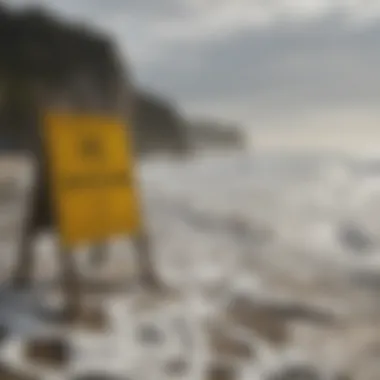
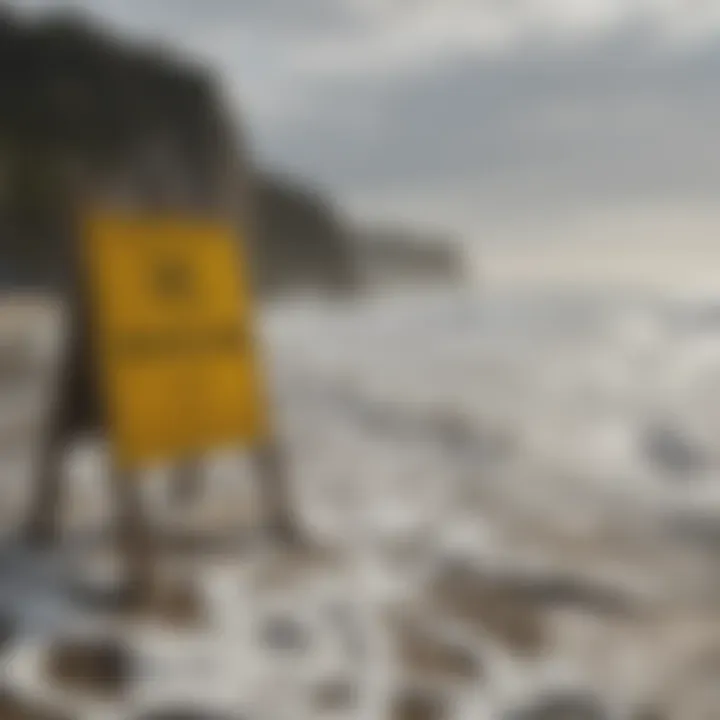
Important Note: The more aware a beachgoer is of these geographical nuances, the better prepared they will be to avoid hazardous conditions.
In summary, exploring the mechanics of rip tide formation reveals that it's a complex relationship between wave dynamics, geographical characteristics, and water movement. With this grasp of the contributing factors, individuals can make informed decisions about water activities, ultimately leading to safer beach experiences.
Identifying Rip Tides
Understanding how to identify rip tides is of utmost importance, especially for those who frequent the ocean for various water activities. Knowing what to look for can not only ensure personal safety but also help in guiding others away from potential danger. With the increasing number of beachgoers each year, awareness becomes even more essential.
The ability to spot a rip tide can make the difference between a peaceful day at the beach and a dangerous situation. Understanding the visual cues, water color, and the role of wind and swell direction can aid both seasoned surfers and casual swimmers in making informed decisions before diving into the water. Identifying these hazards not only promotes safety but also encourages a respect for the ocean's dynamic nature.
Visual Cues of Rip Tides
When at the beach, keeping an eye open for specific visual cues can help in identifying the presence of a rip tide. Observing patterns in the water’s surface is one key aspect. Rip tides often create a noticeable difference in color or texture compared to surrounding water. For instance, it can appear darker in color or smoother than the choppy surface nearby.
Another major cue is the direction of waves. If some waves are breaking smoothly while others are not, meaning that certain areas appear calmer because water is moving seaward, it's a strong indicator of a rip tide. Other signs include:
- Foamy water: Rip tides often churn up debris or foam, creating a bubbly appearance.
- Choppiness: Look for waves that are inconsistent. If waves are closing together and then suddenly calm in one section, there’s a likelihood of a rip current.
Awareness of these subtle indicators can prepare beach enthusiasts to avoid areas that are likely to pose risks, thereby promoting a safer beach experience.
Understanding Water Color and Patterns
Water color and patterns can tell stories; they reveal much about what’s happening beneath the surface. A noticeably streaky or discolored area indicates potential rip currents. Rip tides can carry sand, seaweed, and other debris away from the shore, creating a distinct line or current.
An experienced observer may notice:
- Sandy water: Water being pushed out to sea can appear muddy or brownish.
- Contrasting areas: Rip currents and their surrounding waters may display sharp contrasts in color—what seems like a river flowing within the ocean often indicates a rip tide.
Comprehending these patterns forms a critical element in identifying rip tides, which is vital for ensuring the safety of those enjoying water activities.
Role of Wind and Swell Direction
The wind and swell direction can significantly affect how rip tides form and their strength. Typically, stronger winds lead to larger waves, increasing the flow of water towards the shore. However, when the wave energy is funneled into narrow channels—like those existing between sandbars—a rip tide can be created.
Here are some insights regarding these factors:
- Onshore winds: They often create larger surf, enhancing the risk for rip currents during high tide.
- Offshore winds: These winds can weaken incoming waves, potentially reducing rip tide formation.
Understanding the patterns dictated by wind and swell direction gives deeper insight into when and where rip tides may appear. This combined knowledge empowers individuals to make informed choices that could protect their lives and the lives of others.
"An informed swimmer is a safer swimmer."
Safety Measures in Rip Tide Areas
Rip tides can turn a serene day at the beach into a perilous situation in seconds. Thus, understanding safety measures in these areas is not just advisable; it’s essential. The unpredictable nature of rip currents means that even the most seasoned swimmers can find themselves in a tight spot, making it paramount to be prepared and informed.
Preparedness Before Entering the Water
Preparing for a swim in the ocean goes beyond just packing a towel and sunscreen. The first line of defense is to be aware of the conditions and surroundings. Before submerging, consider these crucial steps:
- Check Warning Signs: Beaches often have flags or signs that indicate current conditions. A red flag usually signals dangers like high surf or rip currents. Ignoring these signs can be like tempting fate.
- Observe the Surf: If the waves appear choppy or you see breaking water creating strong channels, those rip currents might be lurking. Having a keen eye can help you stay safe and out of harm's way.
- Understand Your Limits: It’s wise to know your own swimming abilities and recognize when it's better to stay ashore. If you aren't confident in your strength in challenging water, it’s best to. Well, just relax on the beach!
How to Respond If Caught in a Rip Tide
Knowing how to react when faced with a rip tide can make the difference between panic and safety. Here’s what to keep in mind:
Stay Calm
The first thing to remember is to stay calm. Panic, you see, is a breeding ground for mistakes. When you keep a cool head, your thinking becomes clearer, allowing for better decisions. In a rip tide, the situation can feel daunting. Yet, the key characteristic of remaining calm is that it helps conserve energy, which is vital for the steps that follow.
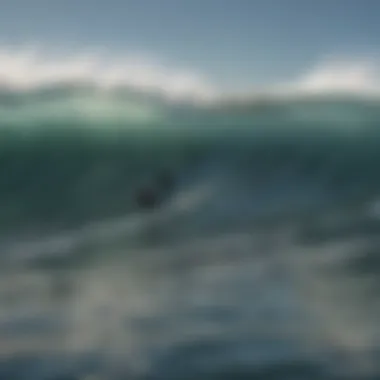
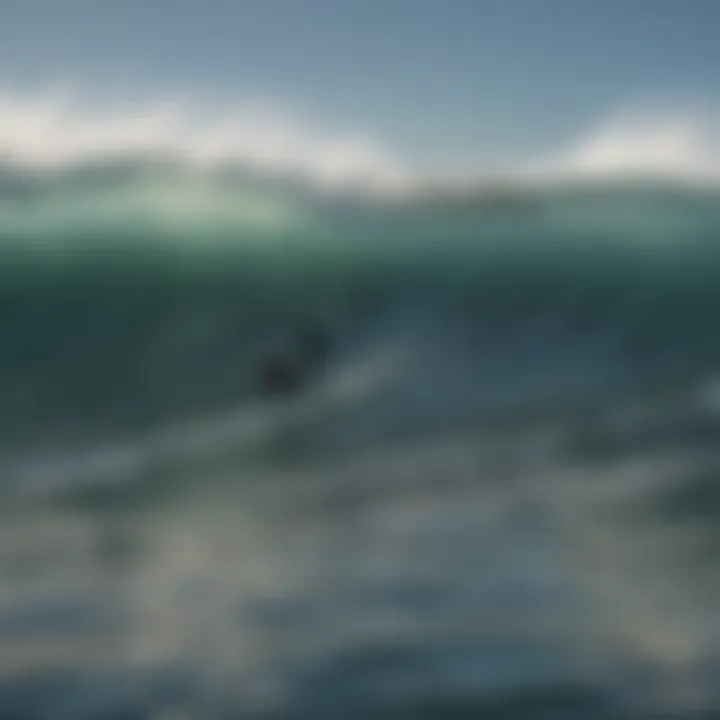
"Staying calm is not just about thinking straight; it's about conserving that much-needed energy for swimming out to safety."
One unique feature of staying calm is that it can even affect your movements in the water. Rather than flailing and wasting energy, solid, deliberate strokes can propel you forward effectively while keeping you closer to the surface of the water. In a rip tide scenario, this character trait can be a life-saver.
Swim Parallel to Shore
The advice often given by lifeguards is to swim parallel to the shore. This choice becomes immensely beneficial when caught in a rip tide.
The key characteristic of this approach is that it does not fight the current directly. Instead of exhausting yourself by trying to swim against the tide, moving sideways allows you to escape the grip of the current more effectively. This tactic can mean the difference between confusion and reaching safety.
A unique feature of this method is its simplicity. Once you understand how to swim parallel, it becomes a repeatable action you can rely on in similar situations. While it may take work, the advantage of steering clear of the rip’s grasp is worth every effort.
Signal for Help
If the situation becomes too tough, signaling for help becomes critical. This idea may sound simple, but it can be a game-changer. If you find yourself struggling, raising your arms and waving can alert lifeguards or nearby beachgoers.
The key characteristic of this approach lies in its potential effectiveness. People often overlook the power of visibility when caught in distress. Simply calling out to someone can lead them to assist you, enabling them to reach you quickly if needed.
A unique feature of this method is its ease of execution. Most individuals can shout or signal without needing any prior training. However, depending on the distance from the shore, it may not always reach those who can help, which is a notable drawback. Nonetheless, it remains an essential response technique to remember.
Overall, these safety measures can keep you ahead of rip tides, transforming what could be a dangerous experience into one where knowledge prevails over panic.
Psychological Aspects of Potential Rip Tide Incidents
When discussing rip tides, it’s essential not only to consider the physical dynamics but also the psychological dimensions that can impact individuals who find themselves in these currents. The threat posed by rip tides can induce significant fear and anxiety, often leading to panic. Understanding these emotional responses can enhance safety and preparedness for water activities, especially among sports enthusiasts and instructors who engage regularly in ocean environments.
Understanding Fear and Panic
Fear is a natural response, particularly when confronting the unknown. In the case of rip tides, a sudden realization that one is being swept away can trigger an overwhelming sense of panic. This panic can cloud judgment and result in poor decision-making. Research indicates that in high-stress situations, the body shifts into fight-or-flight mode, which can skew perceptions of reality.
Here are some common manifestations that can arise:
- Dissonance in judgment: Panic can make individuals believe they are in more danger than they might actually be. They might overestimate the distance from the shore or underestimate their ability to swim.
- Increased tension: Intense emotions can cause muscles to tighten, which contradicts the need for relaxed swimming techniques. This can exhaust a person more quickly and lead to further anxiety.
- Loss of cognitive clarity: Panic often leads to a foggy mindset; the natural instinct becomes to fight against the tide rather than to utilize strategies that involve swimming parallel to the shore.
Recognizing these psychological effects is crucial because it allows individuals to create coping strategies. By preparing mentally before heading into the water, they can mitigate the impact of fear should a rip tide situation arise.
Mental Preparation for Water Activities
Mental preparation plays a pivotal role in ensuring safety and enjoyment for water sports enthusiasts. Just as one might train their body, working on mental fitness can be equally beneficial. Preparing mentally can make all the difference when facing challenging conditions.
Here are some steps that can be taken:
- Educational Awareness: Familiarizing oneself with the characteristics of rip tides can empower individuals. Understanding how these currents work allows for more informed decisions and reduces fear of the unknown.
- Visualization Techniques: Practicing visualizing oneself calmly swimming parallel to the shore can condition the mind to respond appropriately if faced with a rip tide. This mental rehearsal helps reinforce actions that should be taken in an emergency.
- Breathing Exercises: Techniques such as deep breathing can alleviate stress and anxiety. By focusing on one's breath, clarity can be regained amidst panic, promoting a more rational approach to the situation.
- Simulation Training: Engaging in controlled training scenarios, perhaps under the guidance of a seasoned lifeguard or instructor, can equip individuals with hands-on experience, enhancing confidence.
"The mind can be a powerful ally—or a formidable enemy. Training it is as crucial as training the body."
Rip Tides and Marine Ecology
Understanding the relationship between rip tides and marine ecology is crucial. A rip tide isn't just a threat to swimmers; it plays a vital role in the health and functioning of coastal ecosystems. These currents induce significant water movement, shaping habitats for various marine species, which can have lasting effects on biodiversity. Recognizing rip tides' ecology-friendly contributions helps beachgoers appreciate the ocean's intricate balance and encourages safe engagement with its waters.
Effects on Coastal Ecosystems
Dangling on the shores where the land kisses the sea, rip tides act like nature's water ballet, moving water from shore to deeper areas. These currents don’t just bring thrill-seekers their fears and joys; they also serve as a natural connector within coastal ecosystems.
- Nutrient Redistribution: Rip currents effectively transport nutrients from the ocean floor to upper layers where sunlight fosters algae and plankton growth. This uptick in nutrients can directly influence fish populations which, in turn, affects larger marine animals higher up the food chain.
- Habitat Formation: The constant ebb and flow serve as architects of the shorelines. By sculpting sandbars and altering the shape of coastlines, these currents create a diverse array of habitats for various organisms. This variability leads to a rich tapestry of life, from tiniest amphipods to larger crustaceans.
- Biodiversity Increase: Areas affected by rip tides often house higher levels of biodiversity. Species of fish, crustaceans, and invertebrates find niches in the ever-shifting sediments, which helps sustain the larger wildlife that thrives on them. These spontaneous ecosystems contribute to a balanced marine environment.
As such, understanding the effect of rip tides on the ecosystem is not merely an academic exercise. That knowledge is crucial. It highlights the connection between the fun of water sports and the preservation of marine habitats, urging enthusiasts to tread carefully amid their adventure.
Rip Tides as Part of Natural Processes
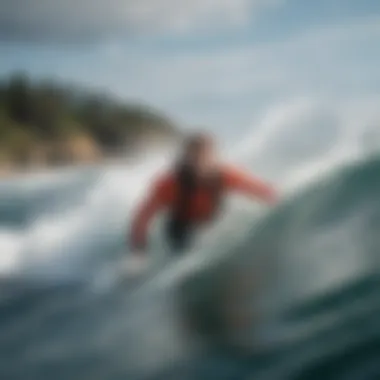
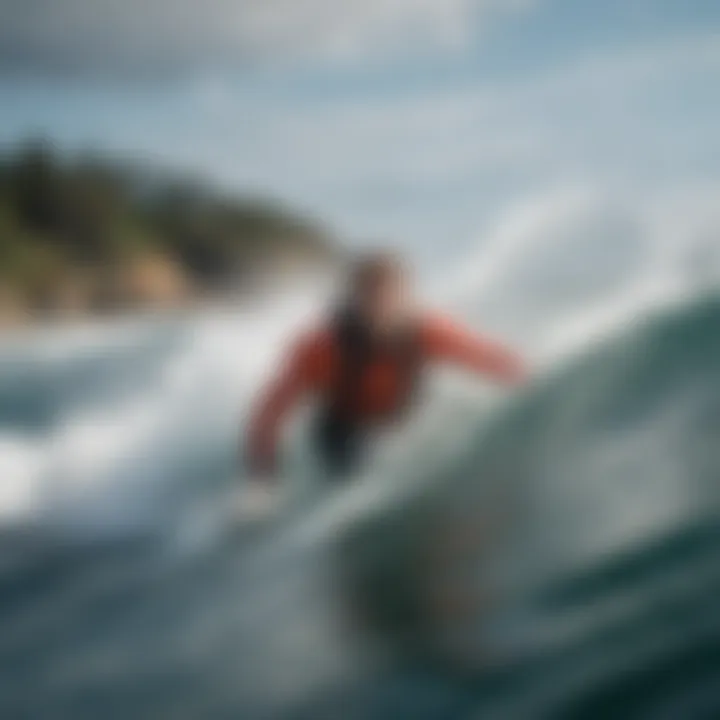
Rip tides shouldn’t be seen only as formidable forces to be tested or feared; they are integral components of natural processes essential for coastal health. These currents demonstrate nature's unyielding ability to adapt and maintain equilibrium.
- Natural Circulation: Rip tides contribute to the larger oceanic circulation systems. The pattern of water movement they create can enhance the overall quality of ocean waters, facilitating the transport of larvae, plankton, and nutrients, which are vital for life cycles of many species.
- Erosion Control: By redistributing sediments, rip tides help maintain coastal lines, sometimes counteracting erosion through their cyclical action. They nourish beaches and foster healthy growth of vegetative cover—important for fighting shoreline erosion.
- Role in Climate Regulation: As currents move and mix waters, they help maintain temperatures and salinity levels suitable for various habitats. This quirky few hundred meters of ocean plays its part in climate regulation, influencing weather patterns and marine life.
In summary, rip tides are natural entities that manage the dynamics of marine environments. Acknowledging these roles encourages a more profound respect for the ocean and its cycles, as well as promotes informed and responsible recreational practices by the beach-goers. This intertwining of adventure and environment underscores the importance of being mindful of ecological consequences while indulging in watersport activities.
Research and Technological Advances
In recent years, the landscape surrounding rip tide research and safety technology has undergone significant evolution. Understanding rip tides is more than just a matter of physics; it’s about protecting lives and enriching the experience of water activities. Advances in research provide valuable insights into how rip tides behave under various conditions, enabling better strategies for safety in coastal regions. Moreover, technological innovations are pivotal in translating this knowledge into practical tools that can be utilized by beachgoers, lifeguards, and local authorities alike.
Recent Studies on Rip Tide Behavior
Recent studies have continuously highlighted the complexities of rip tide dynamics. One noteworthy study from the Journal of Coastal Research explores the correlation between local wind patterns and rip tide formation. These findings are instrumental as they help understand rip tides' variability based on environmental conditions, which can vary significantly from one beach to another.
Researchers have used advanced modeling techniques to simulate different environmental factors that contribute to rip tide formations, such as wave height, wind speed, and coastal topography. Such models often reveal the conditions under which rip tides are most likely to occur, allowing for predictive capabilities that inform safety measures. This leads to enhanced beach advisory systems and can be crucial in minimizing accidents during peak beach days when the number of water sports enthusiasts is high.
Moreover, community-engaged research has shown promising results in educating the public. Initiatives that involve local communities and frequent beach visitors can raise awareness about dangers associated with rip tides.
"Continuous education and research help save lives. They make a difference in how people approach water activities."
Innovations in Water Safety Technology
The synergy of innovation and safety cannot be overstated, especially when discussing rip tides. Recent advancements in technology have introduced a variety of tools designed specifically to enhance water safety. For instance, specialized buoy systems equipped with sensors can monitor rip tide conditions in real-time. These buoys relay critical information regarding current velocity and direction, which can be accessed online by beach management systems.
Another significant development is in mobile applications aimed at water safety. These apps provide valuable features, such as:
- Rip tide alerts: Notifications about current conditions of rip tides based on local data.
- Education resources: Information on how to recognize rip tides and safety tips for beachgoers.
- Weather tracking: Integration of weather patterns that correlate with rip tide formations.
Surveillance drones have also become more prevalent in monitoring ocean conditions. They can quickly assess currents and relay information regarding the presence of rip tides to local authorities or lifeguards. This not only augments their capacity for rapid response but also enhances overall safety for beach users.
Community Awareness and Education
The subject of community awareness and education regarding rip tides is paramount, especially for those who frequent coastal areas. Understanding the nature of these currents helps not only in personal safety measures but also fosters a community that values and prioritizes water safety. The complexity of rip tides can breed misunderstanding and misperceptions, which can be dangerous. Thus, it is crucial to bridge the knowledge gap among beachgoers, instructors, and local residents.
Awareness campaigns are essential for disseminating vital information about the signs of rip tides and the best practices for safe swimming. From community workshops to practical demonstrations, educational programs can empower individuals. When the public is well-informed, the chances of accidents and tragic incidents decrease significantly.
Programs for Beachgoers
There's a variety of programs tailored specifically for beachgoers that aim to raise awareness concerning rip tides. These initiatives can make a real difference, as they effectively engage the community and create a culture of safety.
- Informative Signage: Many beaches now display informative signs outlining the dangers of rip tides. These signs often include visual cues and descriptions to help beachgoers recognize the signs of a rip tide.
- Community Workshops: Local organizations frequently conduct workshops where they educate participants on water safety and rip current identification. These workshops provide practical knowledge and may include simulations to enhance understanding.
- Social Media Campaigns: In the digital age, leveraging social media to spread awareness is incredibly effective. Campaigns that educate the public on the signs of rip tides and offer safety tips can reach a vast audience quickly.
The benefits of these programs go beyond mere education; they serve as a platform for communities to unite in the common goal of safety. Educating those who may be unfamiliar with rip tides helps to cultivate respect for the ocean and widespread adherence to safety measures.
Role of Lifeguards and Local Authorities
Lifeguards and local authorities play a pivotal role in ensuring safety along the coast. Their presence is not just for rescue but also for education and prevention.
- On-The-Spot Education: Lifeguards often engage with swimmers to provide immediate safety tips, such as identifying potential rip currents and understanding their behavior. This proactive approach helps in real-time decision-making.
- Monitoring Conditions: Local authorities are responsible for monitoring beach conditions and may close certain areas if rip tides are particularly strong. Their decision to issue warnings can save lives and encourage prudent behavior among beachgoers.
- Training Programs: Lifeguards undergo rigorous training that includes not only rescue techniques but also awareness on educating the public. This ensures that they are equipped to share knowledge effectively.
"The safest swimmer is an informed swimmer." This phrase encapsulates the essence of community education and the continuous efforts of lifeguards and authorities.
Epilogue: Embracing Water Safety and Knowledge
In the world of water sports, understanding rip tides and their characteristics is not just a matter of safety—it's vital for enhancing the enjoyment and confidence of those who pursue aquatic adventures. The comprehensive knowledge of rip tide dynamics allows beachgoers to navigate these sometimes-treacherous currents with greater awareness, fostering a culture of safety that benefits everyone involved.
The article has highlighted several key points, emphasizing that recognizing the signs of rip tides can make a life-saving difference. For instance, observing different water colors or surface patterns can help in identifying potential rip currents. Knowledge about these indicators empowers individuals to make informed decisions before setting foot in the water.
Moreover, being aware of the psychological aspects tied to rip tides—such as fear and anxiety—can significantly impact a person's reaction in high-stress situations. By mentally preparing for various scenarios, individuals can cultivate a sense of composure, ensuring they are more capable of executing effective responses should they find themselves caught in a swift current. This mental readiness can greatly reduce panic and enable swimmers to take practical measures, like swimming parallel to the shore, instead of fighting against the tide.
Benefits of Embracing Safety Knowledge
- Informed Decisions: Understanding how to identify rip tides enables individuals to choose safer times and places for swimming or surfing.
- Increased Confidence: With knowledge comes the assurance that a person can handle unexpected situations, leading to a more enjoyable experience in the water.
- Community Safety: When beachgoers are educated about rip tide risks, the entire community benefits from a safer beach environment.
"Awareness of one’s surroundings can be the difference between a fun day at the beach and a life-threatening situation."







